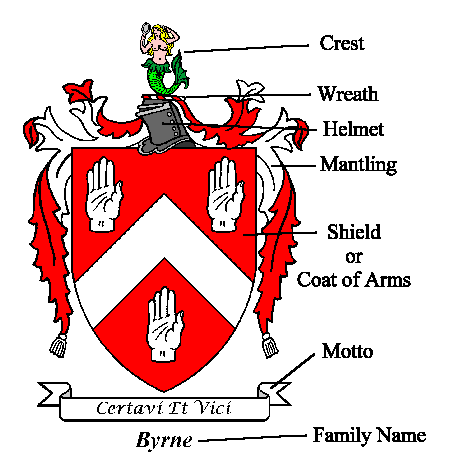Back to Index
Components of a Heraldic Achievement

A Family Achievement of Arms is usually comprised of a number of different components as shown above.
The family Coat of Arms is the Family Shield. The term comes from the fact the design used to be embroidered on a tunic, hence 'Coat', this design was usually given to a knight once he became entitled to bear Arms. The design could then also be used as a uniform for the servants of the household. When the knight went to war the design was not only worn on the tunic but was also put on the shield, as it was the largest piece of equipment the knight had and as the shield was easily seen it made sense to have the design put upon it so people could see who was who at a distance on the battlefield.
The family Crest was a design that was placed upon the Helmet. The early type of crest was a plume of horsehair (like the Roman soldiers) which helped deflect any sword blow coming down on the head and to distinguish the leaders from the common soldier. Later on different designs were used, the most popular was an arm or hand holding a sword.
Not all families would have a Crest but most would have a Coat of Arms.
The Mantling or Lambrequin was a cloth covering, usually in the two main colours of the Arms, that covered the Helmet. It protected the wearer from heat and perhaps prevented the Helmet from rust. It also afforded an additional protection from sword attacks by deadening the blow and possibly entangling the weapon. Due to this the Mantling is usually depicted in a cut or ragged form.
The Wreath was made from twisted cloths of the same colours as the Mantling. It was used to cover the place where the Crest was fixed to the Helmet.
The Helmet or Helm can be found in many different shapes and styles depending on the century when the artwork was produced, but it usually the Esquire's Helm which is used. There are four main types of Helmet which are used to show the rank of the owner of the Arms.
The full-faced helm in gold is given to Kings and Princes of the Blood Royal.
The helmet of the Nobility is made of steel with bars of gold and depicted in profile.
The helmet of Baronets is made of steel and shown full-faced with the visor thrown back and without bars.
The helmet of the Esquire is made of steel and always shown in profile with the visor closed.
The family Motto was originally a war cry used by the knight in battle or a saying used by the family. These were usually recorded in Latin or Norman French but some of the Old Irish Mottos are found in Gaelic and a few modern Mottos are in English.
Again not all families would have a Motto recorded.
The Family Name or Surname is the name which the family is usually know by. Surnames came into being during Medieval times and usually can fall into one of the four main categories.
The first group would be based on the first name of an ancestor, such as O'Brien.
The second group would be taken from the place where the ancestor originated, such as Greenwood.
The third group would record the ancestor's occupation or status, such as Smith.
The final group records an ancestors nickname or description, such as Small.
If a family was granted a Coat of Arms, Crest and Motto this trio is termed as an Heraldic Achievement. In a few cases if the family became Earls or higher they could also be awarded Supporters. These would be creatures or humans who held up the shield on the family Seal. Arms were issued to both Warriors and Non-combatants. A non-combatant would be Men of the Cloth such as Bishops and Land-Owning Priests. Others could be wealthy land-owning women. To be completely accurate these Arms should be place upon a diamond design rather then a shield.
Inquiries via e-mail:

|
Coat Of Arms Prints First Names Special Occasion Plaques |
Headed Notepaper
Wedding Stationery Heraldic Symbols |